University Business Research: Employee Wages, Hours, and Fairness
VerifiedAdded on 2020/03/01
|90
|13335
|48
Report
AI Summary
This business research methodology report examines the concept of fairness in employee wages, work hours, and other considerations. The study investigates the impact of fairness on employee performance and organizational outcomes, exploring how wage structures, flexibility, and career growth opportunities affect employee engagement and productivity. The research includes a literature review of 30 journals, a primary analysis involving a survey of employees at the School of Business and Hospitality, and the use of statistical tools such as SPSS. The findings reveal insights into the current employment practices, with specific attention to how fairness in wages and work flexibility influence employee satisfaction and organizational commitment. The report concludes with recommendations for improving employment practices and addresses the existing research gaps by incorporating primary data and focusing on the practical aspects of fairness in the workplace. The report is a contribution to Desklib, providing valuable insights for students studying business and related fields.

Running head: BUSINESS RESEARCH METHODOLOGY
Business Research Methodology
Examining the concept of fairness in employee wages, hours and other consideration
Name of the student
Name of the University
Author note
Business Research Methodology
Examining the concept of fairness in employee wages, hours and other consideration
Name of the student
Name of the University
Author note
Paraphrase This Document
Need a fresh take? Get an instant paraphrase of this document with our AI Paraphraser
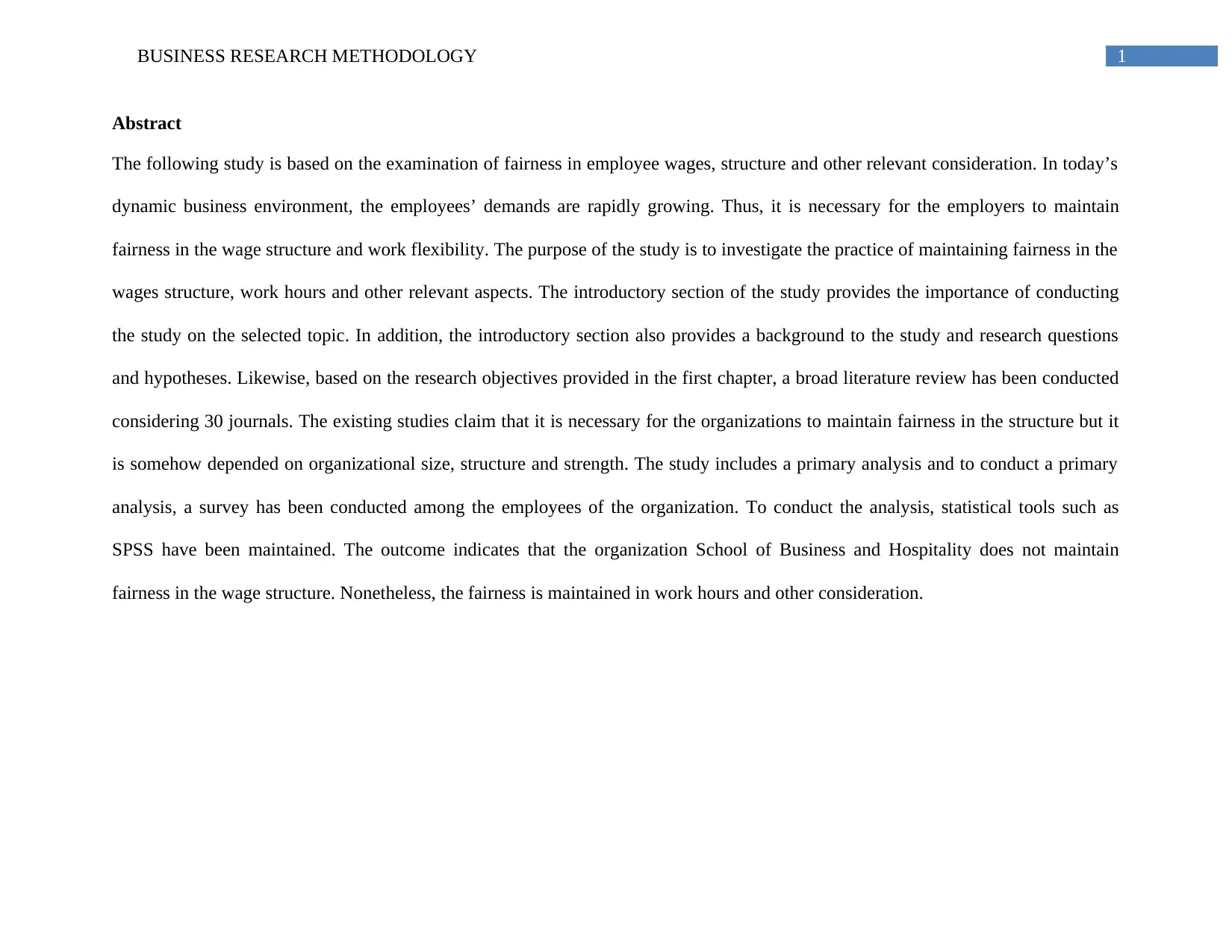
1BUSINESS RESEARCH METHODOLOGY
Abstract
The following study is based on the examination of fairness in employee wages, structure and other relevant consideration. In today’s
dynamic business environment, the employees’ demands are rapidly growing. Thus, it is necessary for the employers to maintain
fairness in the wage structure and work flexibility. The purpose of the study is to investigate the practice of maintaining fairness in the
wages structure, work hours and other relevant aspects. The introductory section of the study provides the importance of conducting
the study on the selected topic. In addition, the introductory section also provides a background to the study and research questions
and hypotheses. Likewise, based on the research objectives provided in the first chapter, a broad literature review has been conducted
considering 30 journals. The existing studies claim that it is necessary for the organizations to maintain fairness in the structure but it
is somehow depended on organizational size, structure and strength. The study includes a primary analysis and to conduct a primary
analysis, a survey has been conducted among the employees of the organization. To conduct the analysis, statistical tools such as
SPSS have been maintained. The outcome indicates that the organization School of Business and Hospitality does not maintain
fairness in the wage structure. Nonetheless, the fairness is maintained in work hours and other consideration.
Abstract
The following study is based on the examination of fairness in employee wages, structure and other relevant consideration. In today’s
dynamic business environment, the employees’ demands are rapidly growing. Thus, it is necessary for the employers to maintain
fairness in the wage structure and work flexibility. The purpose of the study is to investigate the practice of maintaining fairness in the
wages structure, work hours and other relevant aspects. The introductory section of the study provides the importance of conducting
the study on the selected topic. In addition, the introductory section also provides a background to the study and research questions
and hypotheses. Likewise, based on the research objectives provided in the first chapter, a broad literature review has been conducted
considering 30 journals. The existing studies claim that it is necessary for the organizations to maintain fairness in the structure but it
is somehow depended on organizational size, structure and strength. The study includes a primary analysis and to conduct a primary
analysis, a survey has been conducted among the employees of the organization. To conduct the analysis, statistical tools such as
SPSS have been maintained. The outcome indicates that the organization School of Business and Hospitality does not maintain
fairness in the wage structure. Nonetheless, the fairness is maintained in work hours and other consideration.

2BUSINESS RESEARCH METHODOLOGY
Acknowledgement
By this research, I have experienced best possible learning of my life. By conducting this research I have learnt various concepts,
models and theories. I first thank to the almighty God. After that I want to thank to my supervisor ______________ who is my friend,
philosopher and guide. I also thank my parents for being supportive and accommodative for completing this research. I want to thank
my friends for giving me the moral support while conducting this research.
Acknowledgement
By this research, I have experienced best possible learning of my life. By conducting this research I have learnt various concepts,
models and theories. I first thank to the almighty God. After that I want to thank to my supervisor ______________ who is my friend,
philosopher and guide. I also thank my parents for being supportive and accommodative for completing this research. I want to thank
my friends for giving me the moral support while conducting this research.
⊘ This is a preview!⊘
Do you want full access?
Subscribe today to unlock all pages.

Trusted by 1+ million students worldwide

3BUSINESS RESEARCH METHODOLOGY
Table of Contents
CHAPTER 1: INTRODUCTION....................................................................................................4
1.1 Introduction............................................................................................................................4
1.2 Background of the study........................................................................................................5
1.3 Problem statement.................................................................................................................6
1.4 Research aim and Objectives.................................................................................................6
1.5 Research Questions................................................................................................................7
1.6 Research hypothesis...............................................................................................................7
1.7 Dissertation Structure............................................................................................................8
1.8 Summary................................................................................................................................8
CHAPTER 2: LITERATURE REVIEW.........................................................................................9
2.1 Introduction............................................................................................................................9
2.2 Fairness and work effect........................................................................................................9
2.3 Balancing the pay scale: Fair vs. Unfair..............................................................................10
Table of Contents
CHAPTER 1: INTRODUCTION....................................................................................................4
1.1 Introduction............................................................................................................................4
1.2 Background of the study........................................................................................................5
1.3 Problem statement.................................................................................................................6
1.4 Research aim and Objectives.................................................................................................6
1.5 Research Questions................................................................................................................7
1.6 Research hypothesis...............................................................................................................7
1.7 Dissertation Structure............................................................................................................8
1.8 Summary................................................................................................................................8
CHAPTER 2: LITERATURE REVIEW.........................................................................................9
2.1 Introduction............................................................................................................................9
2.2 Fairness and work effect........................................................................................................9
2.3 Balancing the pay scale: Fair vs. Unfair..............................................................................10
Paraphrase This Document
Need a fresh take? Get an instant paraphrase of this document with our AI Paraphraser

4BUSINESS RESEARCH METHODOLOGY
2.4 Transparency and a commitment to equity to the paycheck................................................12
2.5 Wages differential, fairness and social comparison............................................................13
2.6 Practice of maintaining fairness work through the equity...................................................15
2.7 Best and the rest- Boundary-less fairness............................................................................16
2.8 Job Satisfaction and Organizational commitment...............................................................17
2.9 Research Gap and Contribution...........................................................................................17
2.10 Summary............................................................................................................................18
CHAPTER 3: RESEARCH METHODOLOGY...........................................................................19
3.1 Introduction..........................................................................................................................19
3.2 Research Philosophy............................................................................................................19
3.3 Research Approach..............................................................................................................21
3.4 Research Design..................................................................................................................22
3.5 Data collection techniques...................................................................................................22
3.6 Data analysis techniques......................................................................................................23
2.4 Transparency and a commitment to equity to the paycheck................................................12
2.5 Wages differential, fairness and social comparison............................................................13
2.6 Practice of maintaining fairness work through the equity...................................................15
2.7 Best and the rest- Boundary-less fairness............................................................................16
2.8 Job Satisfaction and Organizational commitment...............................................................17
2.9 Research Gap and Contribution...........................................................................................17
2.10 Summary............................................................................................................................18
CHAPTER 3: RESEARCH METHODOLOGY...........................................................................19
3.1 Introduction..........................................................................................................................19
3.2 Research Philosophy............................................................................................................19
3.3 Research Approach..............................................................................................................21
3.4 Research Design..................................................................................................................22
3.5 Data collection techniques...................................................................................................22
3.6 Data analysis techniques......................................................................................................23
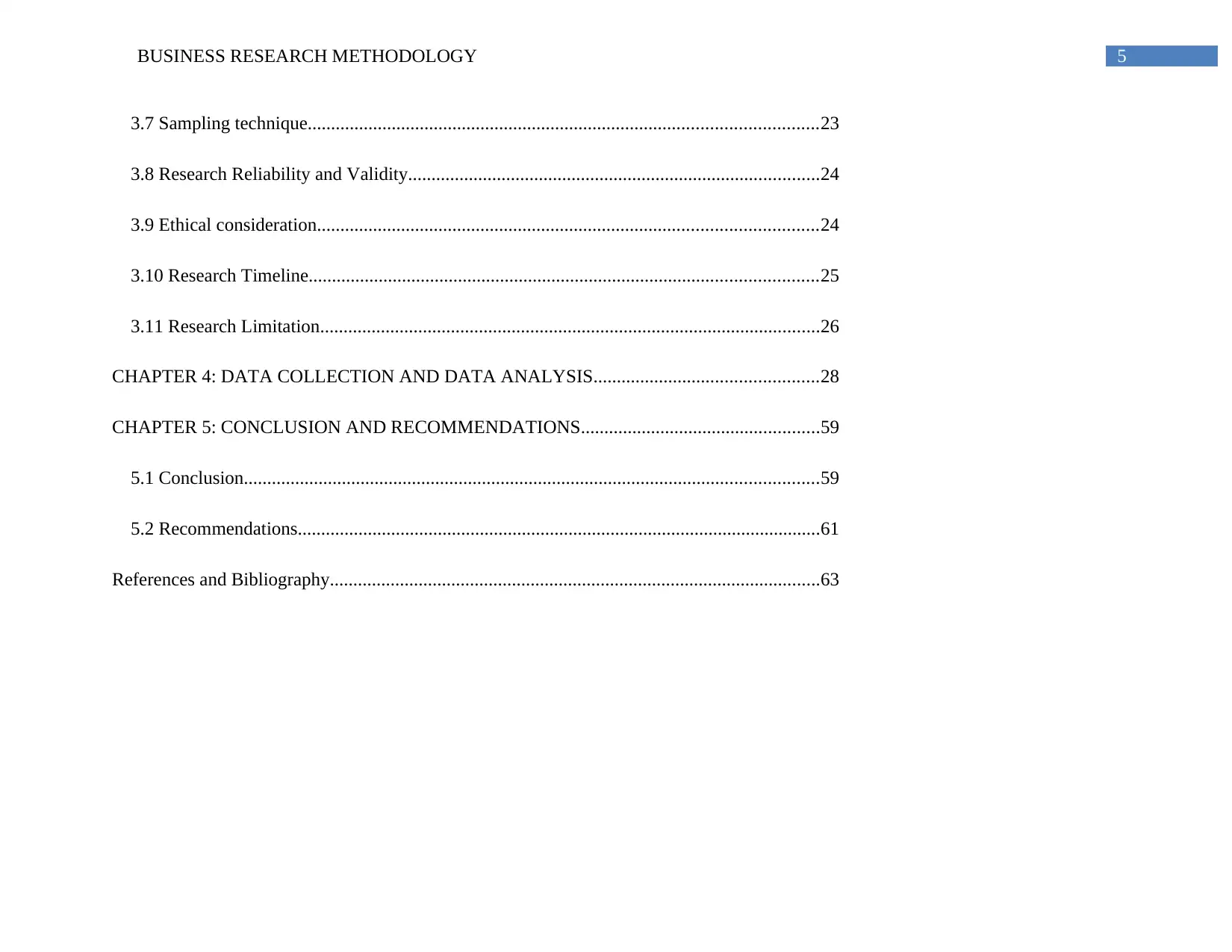
5BUSINESS RESEARCH METHODOLOGY
3.7 Sampling technique.............................................................................................................23
3.8 Research Reliability and Validity........................................................................................24
3.9 Ethical consideration...........................................................................................................24
3.10 Research Timeline.............................................................................................................25
3.11 Research Limitation...........................................................................................................26
CHAPTER 4: DATA COLLECTION AND DATA ANALYSIS................................................28
CHAPTER 5: CONCLUSION AND RECOMMENDATIONS...................................................59
5.1 Conclusion...........................................................................................................................59
5.2 Recommendations................................................................................................................61
References and Bibliography.........................................................................................................63
3.7 Sampling technique.............................................................................................................23
3.8 Research Reliability and Validity........................................................................................24
3.9 Ethical consideration...........................................................................................................24
3.10 Research Timeline.............................................................................................................25
3.11 Research Limitation...........................................................................................................26
CHAPTER 4: DATA COLLECTION AND DATA ANALYSIS................................................28
CHAPTER 5: CONCLUSION AND RECOMMENDATIONS...................................................59
5.1 Conclusion...........................................................................................................................59
5.2 Recommendations................................................................................................................61
References and Bibliography.........................................................................................................63
⊘ This is a preview!⊘
Do you want full access?
Subscribe today to unlock all pages.

Trusted by 1+ million students worldwide
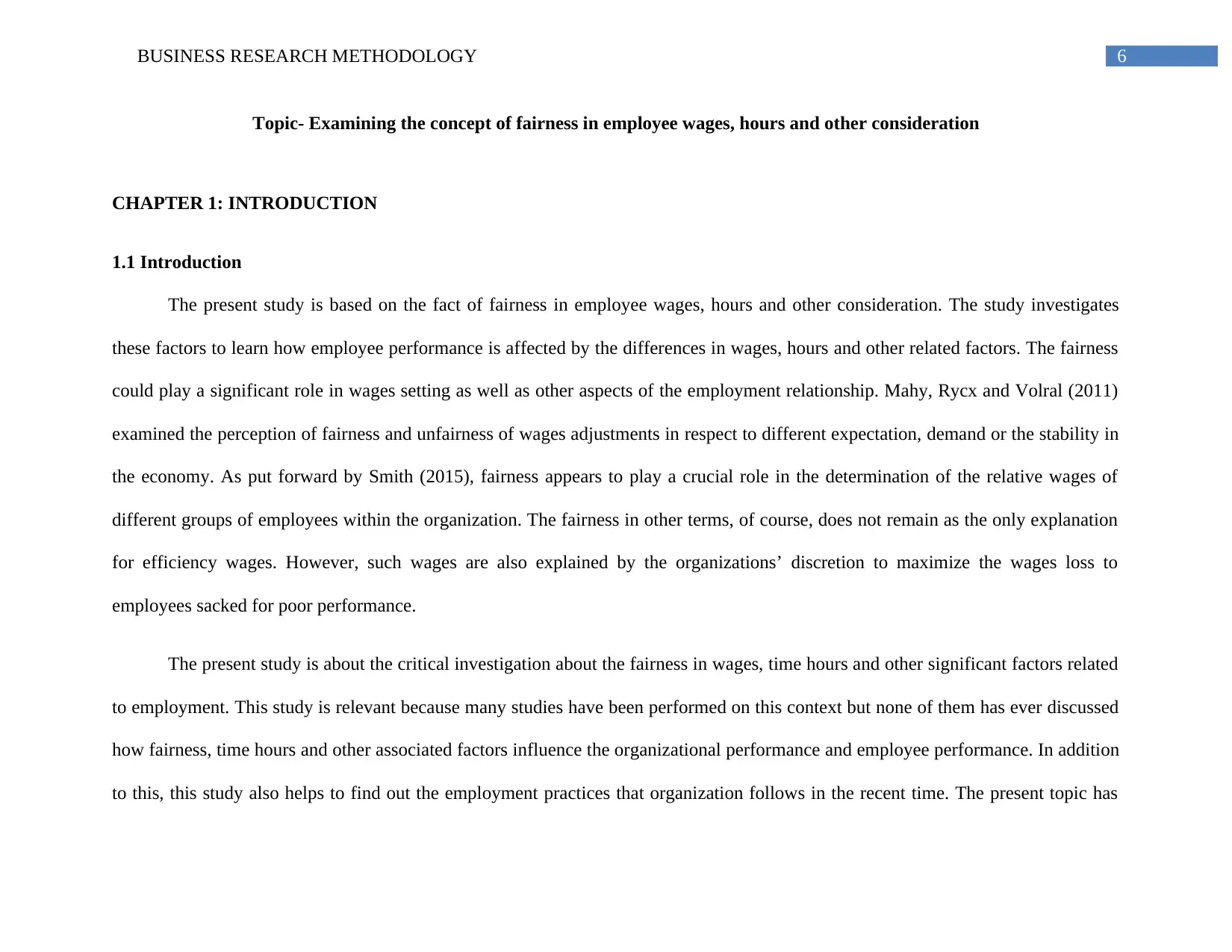
6BUSINESS RESEARCH METHODOLOGY
Topic- Examining the concept of fairness in employee wages, hours and other consideration
CHAPTER 1: INTRODUCTION
1.1 Introduction
The present study is based on the fact of fairness in employee wages, hours and other consideration. The study investigates
these factors to learn how employee performance is affected by the differences in wages, hours and other related factors. The fairness
could play a significant role in wages setting as well as other aspects of the employment relationship. Mahy, Rycx and Volral (2011)
examined the perception of fairness and unfairness of wages adjustments in respect to different expectation, demand or the stability in
the economy. As put forward by Smith (2015), fairness appears to play a crucial role in the determination of the relative wages of
different groups of employees within the organization. The fairness in other terms, of course, does not remain as the only explanation
for efficiency wages. However, such wages are also explained by the organizations’ discretion to maximize the wages loss to
employees sacked for poor performance.
The present study is about the critical investigation about the fairness in wages, time hours and other significant factors related
to employment. This study is relevant because many studies have been performed on this context but none of them has ever discussed
how fairness, time hours and other associated factors influence the organizational performance and employee performance. In addition
to this, this study also helps to find out the employment practices that organization follows in the recent time. The present topic has
Topic- Examining the concept of fairness in employee wages, hours and other consideration
CHAPTER 1: INTRODUCTION
1.1 Introduction
The present study is based on the fact of fairness in employee wages, hours and other consideration. The study investigates
these factors to learn how employee performance is affected by the differences in wages, hours and other related factors. The fairness
could play a significant role in wages setting as well as other aspects of the employment relationship. Mahy, Rycx and Volral (2011)
examined the perception of fairness and unfairness of wages adjustments in respect to different expectation, demand or the stability in
the economy. As put forward by Smith (2015), fairness appears to play a crucial role in the determination of the relative wages of
different groups of employees within the organization. The fairness in other terms, of course, does not remain as the only explanation
for efficiency wages. However, such wages are also explained by the organizations’ discretion to maximize the wages loss to
employees sacked for poor performance.
The present study is about the critical investigation about the fairness in wages, time hours and other significant factors related
to employment. This study is relevant because many studies have been performed on this context but none of them has ever discussed
how fairness, time hours and other associated factors influence the organizational performance and employee performance. In addition
to this, this study also helps to find out the employment practices that organization follows in the recent time. The present topic has
Paraphrase This Document
Need a fresh take? Get an instant paraphrase of this document with our AI Paraphraser
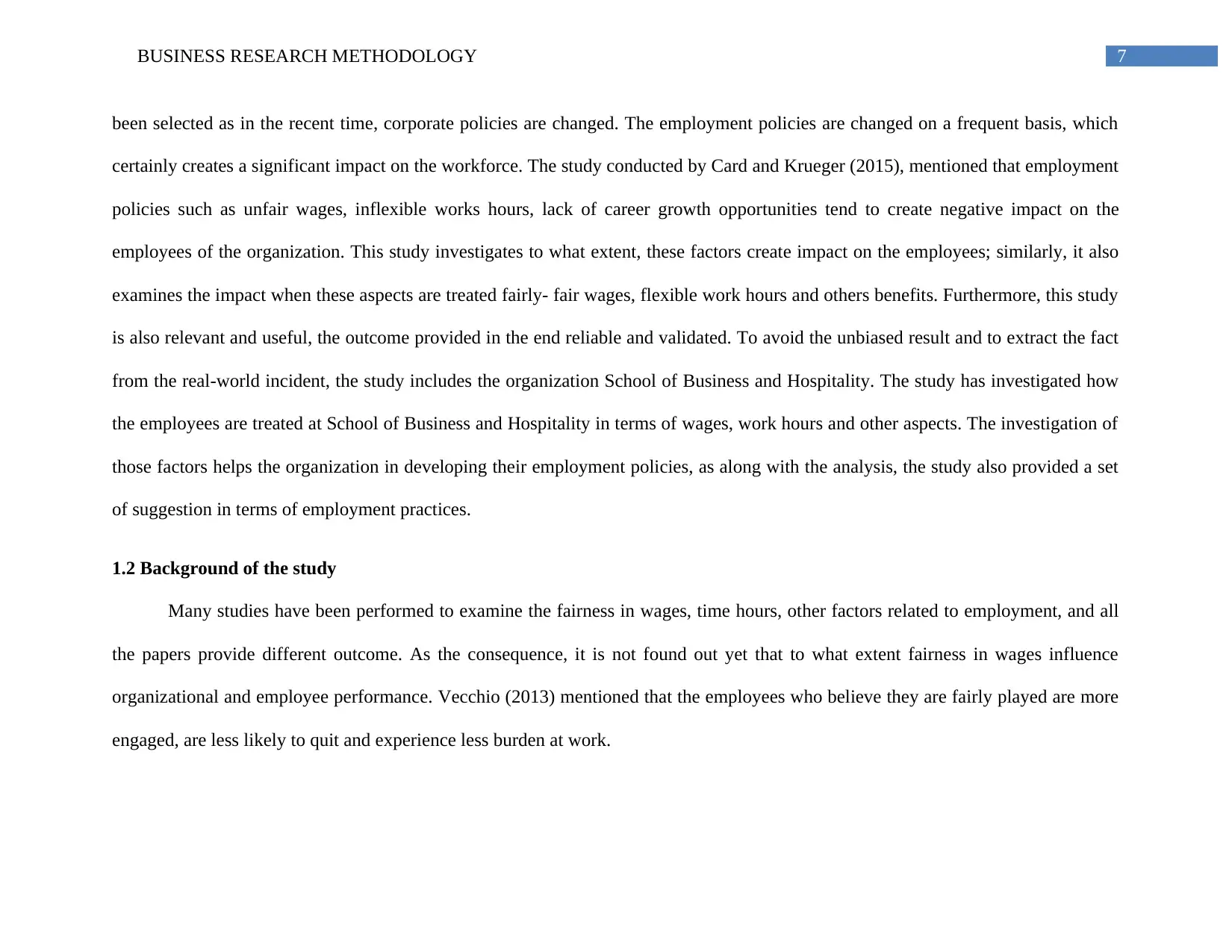
7BUSINESS RESEARCH METHODOLOGY
been selected as in the recent time, corporate policies are changed. The employment policies are changed on a frequent basis, which
certainly creates a significant impact on the workforce. The study conducted by Card and Krueger (2015), mentioned that employment
policies such as unfair wages, inflexible works hours, lack of career growth opportunities tend to create negative impact on the
employees of the organization. This study investigates to what extent, these factors create impact on the employees; similarly, it also
examines the impact when these aspects are treated fairly- fair wages, flexible work hours and others benefits. Furthermore, this study
is also relevant and useful, the outcome provided in the end reliable and validated. To avoid the unbiased result and to extract the fact
from the real-world incident, the study includes the organization School of Business and Hospitality. The study has investigated how
the employees are treated at School of Business and Hospitality in terms of wages, work hours and other aspects. The investigation of
those factors helps the organization in developing their employment policies, as along with the analysis, the study also provided a set
of suggestion in terms of employment practices.
1.2 Background of the study
Many studies have been performed to examine the fairness in wages, time hours, other factors related to employment, and all
the papers provide different outcome. As the consequence, it is not found out yet that to what extent fairness in wages influence
organizational and employee performance. Vecchio (2013) mentioned that the employees who believe they are fairly played are more
engaged, are less likely to quit and experience less burden at work.
been selected as in the recent time, corporate policies are changed. The employment policies are changed on a frequent basis, which
certainly creates a significant impact on the workforce. The study conducted by Card and Krueger (2015), mentioned that employment
policies such as unfair wages, inflexible works hours, lack of career growth opportunities tend to create negative impact on the
employees of the organization. This study investigates to what extent, these factors create impact on the employees; similarly, it also
examines the impact when these aspects are treated fairly- fair wages, flexible work hours and others benefits. Furthermore, this study
is also relevant and useful, the outcome provided in the end reliable and validated. To avoid the unbiased result and to extract the fact
from the real-world incident, the study includes the organization School of Business and Hospitality. The study has investigated how
the employees are treated at School of Business and Hospitality in terms of wages, work hours and other aspects. The investigation of
those factors helps the organization in developing their employment policies, as along with the analysis, the study also provided a set
of suggestion in terms of employment practices.
1.2 Background of the study
Many studies have been performed to examine the fairness in wages, time hours, other factors related to employment, and all
the papers provide different outcome. As the consequence, it is not found out yet that to what extent fairness in wages influence
organizational and employee performance. Vecchio (2013) mentioned that the employees who believe they are fairly played are more
engaged, are less likely to quit and experience less burden at work.
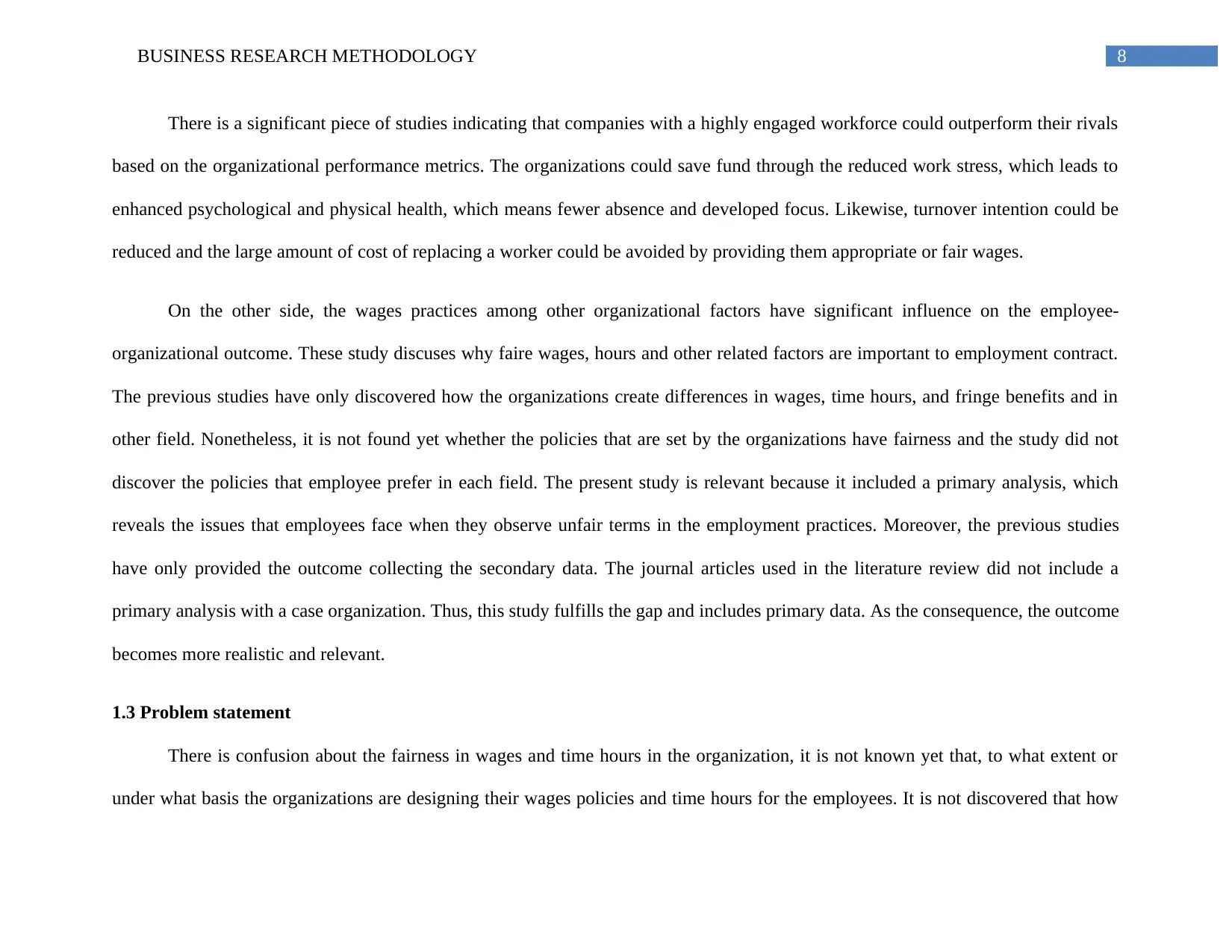
8BUSINESS RESEARCH METHODOLOGY
There is a significant piece of studies indicating that companies with a highly engaged workforce could outperform their rivals
based on the organizational performance metrics. The organizations could save fund through the reduced work stress, which leads to
enhanced psychological and physical health, which means fewer absence and developed focus. Likewise, turnover intention could be
reduced and the large amount of cost of replacing a worker could be avoided by providing them appropriate or fair wages.
On the other side, the wages practices among other organizational factors have significant influence on the employee-
organizational outcome. These study discuses why faire wages, hours and other related factors are important to employment contract.
The previous studies have only discovered how the organizations create differences in wages, time hours, and fringe benefits and in
other field. Nonetheless, it is not found yet whether the policies that are set by the organizations have fairness and the study did not
discover the policies that employee prefer in each field. The present study is relevant because it included a primary analysis, which
reveals the issues that employees face when they observe unfair terms in the employment practices. Moreover, the previous studies
have only provided the outcome collecting the secondary data. The journal articles used in the literature review did not include a
primary analysis with a case organization. Thus, this study fulfills the gap and includes primary data. As the consequence, the outcome
becomes more realistic and relevant.
1.3 Problem statement
There is confusion about the fairness in wages and time hours in the organization, it is not known yet that, to what extent or
under what basis the organizations are designing their wages policies and time hours for the employees. It is not discovered that how
There is a significant piece of studies indicating that companies with a highly engaged workforce could outperform their rivals
based on the organizational performance metrics. The organizations could save fund through the reduced work stress, which leads to
enhanced psychological and physical health, which means fewer absence and developed focus. Likewise, turnover intention could be
reduced and the large amount of cost of replacing a worker could be avoided by providing them appropriate or fair wages.
On the other side, the wages practices among other organizational factors have significant influence on the employee-
organizational outcome. These study discuses why faire wages, hours and other related factors are important to employment contract.
The previous studies have only discovered how the organizations create differences in wages, time hours, and fringe benefits and in
other field. Nonetheless, it is not found yet whether the policies that are set by the organizations have fairness and the study did not
discover the policies that employee prefer in each field. The present study is relevant because it included a primary analysis, which
reveals the issues that employees face when they observe unfair terms in the employment practices. Moreover, the previous studies
have only provided the outcome collecting the secondary data. The journal articles used in the literature review did not include a
primary analysis with a case organization. Thus, this study fulfills the gap and includes primary data. As the consequence, the outcome
becomes more realistic and relevant.
1.3 Problem statement
There is confusion about the fairness in wages and time hours in the organization, it is not known yet that, to what extent or
under what basis the organizations are designing their wages policies and time hours for the employees. It is not discovered that how
⊘ This is a preview!⊘
Do you want full access?
Subscribe today to unlock all pages.

Trusted by 1+ million students worldwide
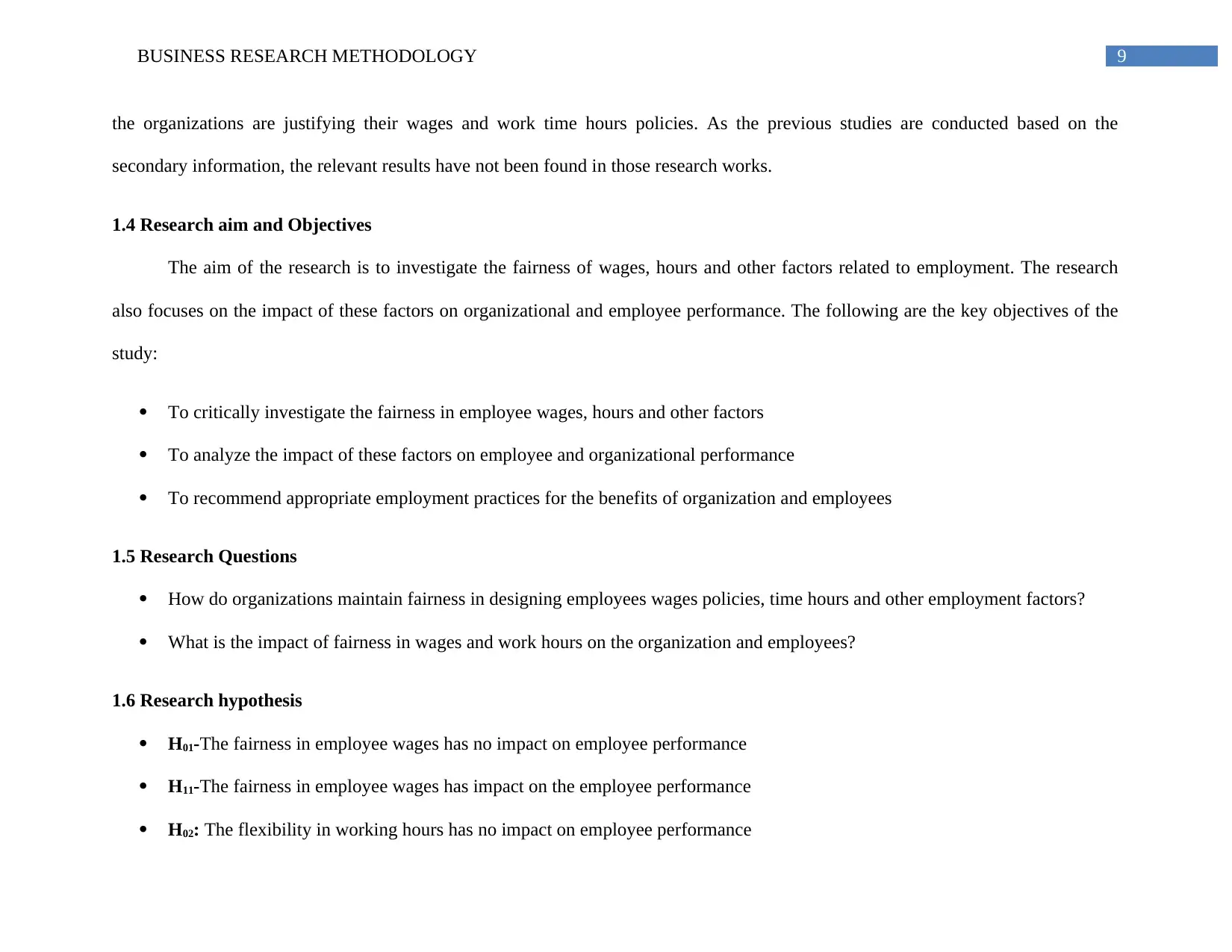
9BUSINESS RESEARCH METHODOLOGY
the organizations are justifying their wages and work time hours policies. As the previous studies are conducted based on the
secondary information, the relevant results have not been found in those research works.
1.4 Research aim and Objectives
The aim of the research is to investigate the fairness of wages, hours and other factors related to employment. The research
also focuses on the impact of these factors on organizational and employee performance. The following are the key objectives of the
study:
To critically investigate the fairness in employee wages, hours and other factors
To analyze the impact of these factors on employee and organizational performance
To recommend appropriate employment practices for the benefits of organization and employees
1.5 Research Questions
How do organizations maintain fairness in designing employees wages policies, time hours and other employment factors?
What is the impact of fairness in wages and work hours on the organization and employees?
1.6 Research hypothesis
H01-The fairness in employee wages has no impact on employee performance
H11-The fairness in employee wages has impact on the employee performance
H02: The flexibility in working hours has no impact on employee performance
the organizations are justifying their wages and work time hours policies. As the previous studies are conducted based on the
secondary information, the relevant results have not been found in those research works.
1.4 Research aim and Objectives
The aim of the research is to investigate the fairness of wages, hours and other factors related to employment. The research
also focuses on the impact of these factors on organizational and employee performance. The following are the key objectives of the
study:
To critically investigate the fairness in employee wages, hours and other factors
To analyze the impact of these factors on employee and organizational performance
To recommend appropriate employment practices for the benefits of organization and employees
1.5 Research Questions
How do organizations maintain fairness in designing employees wages policies, time hours and other employment factors?
What is the impact of fairness in wages and work hours on the organization and employees?
1.6 Research hypothesis
H01-The fairness in employee wages has no impact on employee performance
H11-The fairness in employee wages has impact on the employee performance
H02: The flexibility in working hours has no impact on employee performance
Paraphrase This Document
Need a fresh take? Get an instant paraphrase of this document with our AI Paraphraser
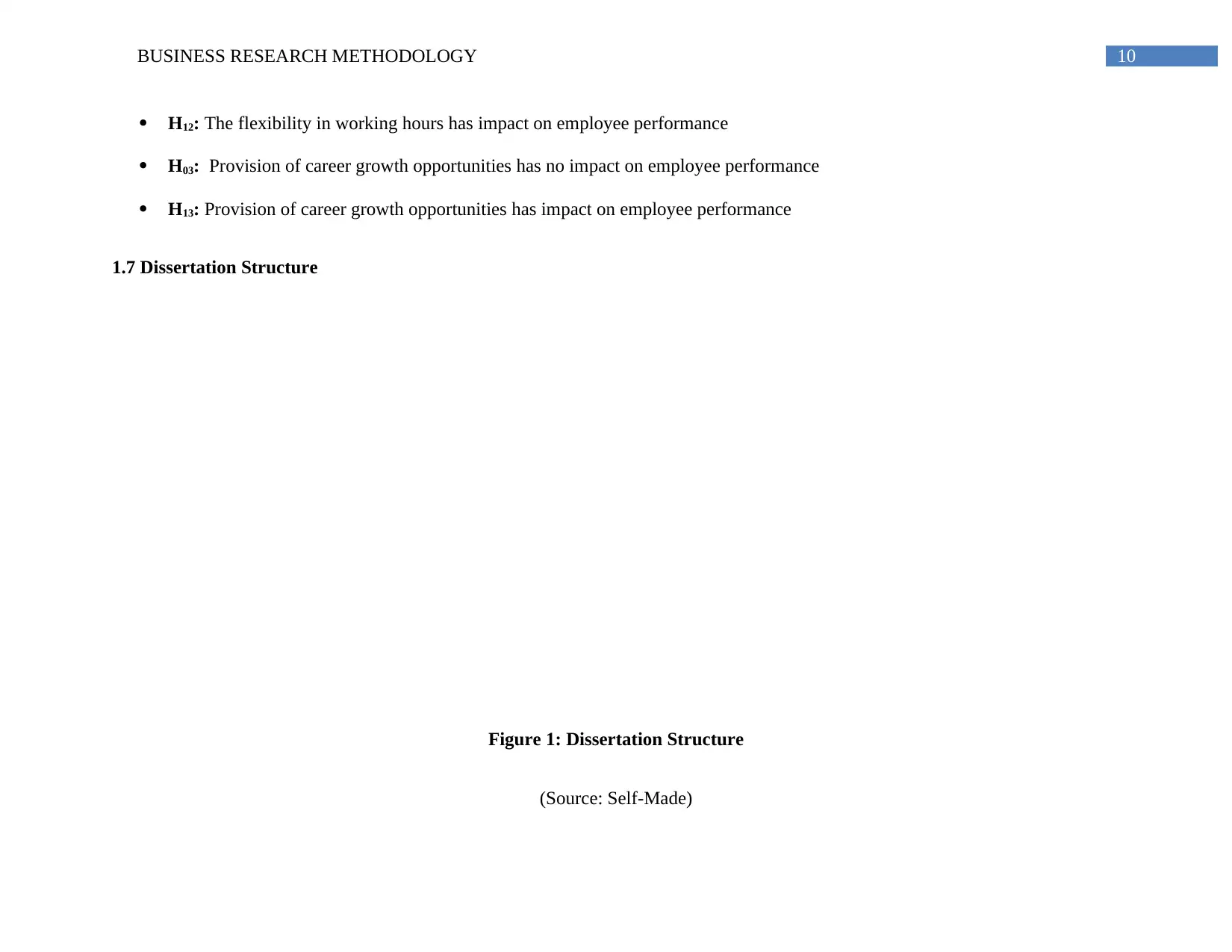
10BUSINESS RESEARCH METHODOLOGY
H12: The flexibility in working hours has impact on employee performance
H03: Provision of career growth opportunities has no impact on employee performance
H13: Provision of career growth opportunities has impact on employee performance
1.7 Dissertation Structure
Figure 1: Dissertation Structure
(Source: Self-Made)
H12: The flexibility in working hours has impact on employee performance
H03: Provision of career growth opportunities has no impact on employee performance
H13: Provision of career growth opportunities has impact on employee performance
1.7 Dissertation Structure
Figure 1: Dissertation Structure
(Source: Self-Made)

11BUSINESS RESEARCH METHODOLOGY
1.8 Summary
This chapter develops the backbone of the entire study. This introductory section of the study presents the variable of the topic.
The chapter presents the fact that there is a difference in the wages, time hours and other aspects of employment policies. The chapter
also provides the fact the previous studies did not focus on how the organizations in the industries maintaining the fairness in the
wages policies. Based on these gaps, the research developed the relevancy of the present study. The chapter also provided the key
research objectives and questions based on which the literature review in the next section has been conducted.
1.8 Summary
This chapter develops the backbone of the entire study. This introductory section of the study presents the variable of the topic.
The chapter presents the fact that there is a difference in the wages, time hours and other aspects of employment policies. The chapter
also provides the fact the previous studies did not focus on how the organizations in the industries maintaining the fairness in the
wages policies. Based on these gaps, the research developed the relevancy of the present study. The chapter also provided the key
research objectives and questions based on which the literature review in the next section has been conducted.
⊘ This is a preview!⊘
Do you want full access?
Subscribe today to unlock all pages.

Trusted by 1+ million students worldwide
1 out of 90
Related Documents
Your All-in-One AI-Powered Toolkit for Academic Success.
+13062052269
info@desklib.com
Available 24*7 on WhatsApp / Email
![[object Object]](/_next/static/media/star-bottom.7253800d.svg)
Unlock your academic potential
Copyright © 2020–2025 A2Z Services. All Rights Reserved. Developed and managed by ZUCOL.





